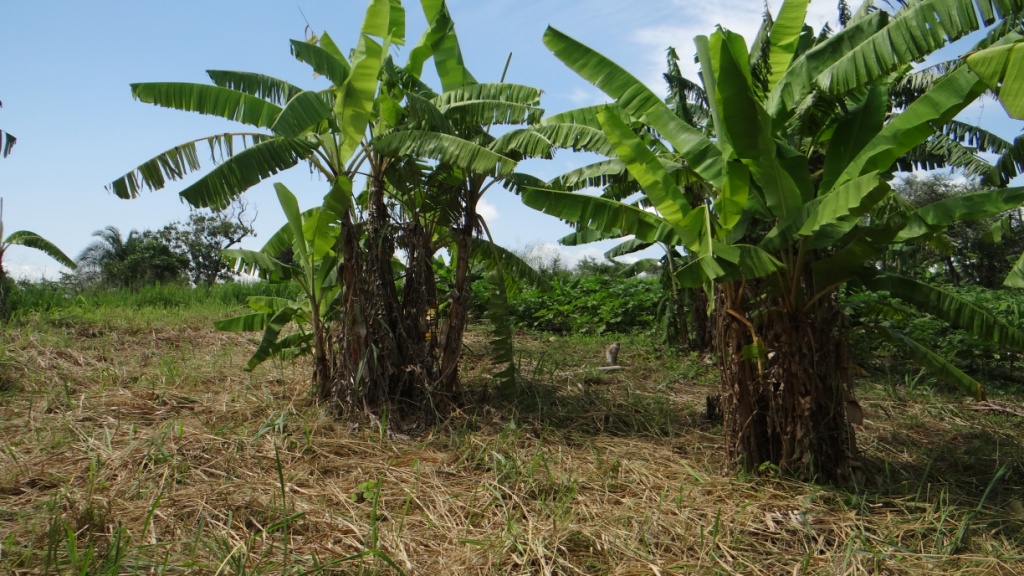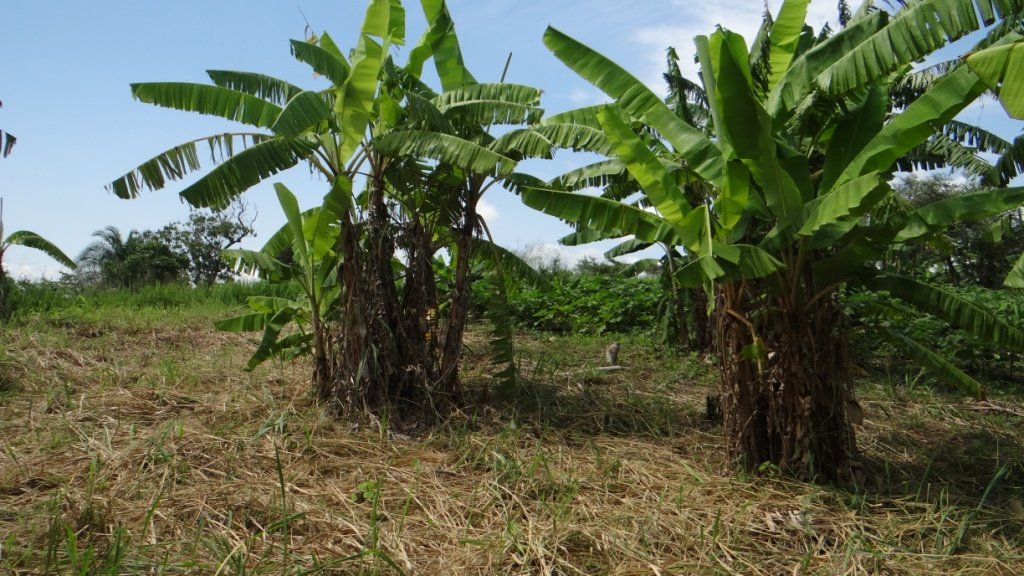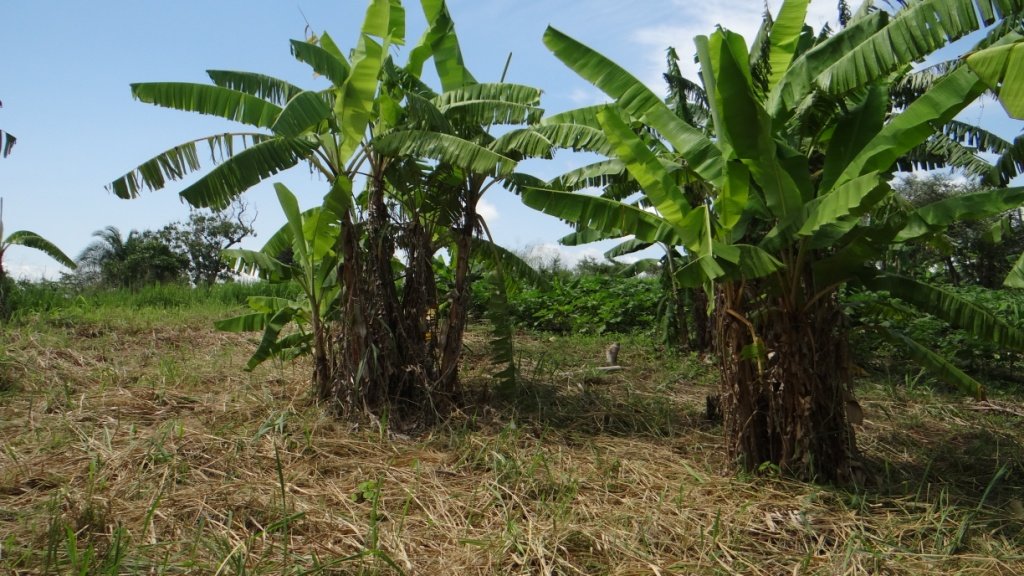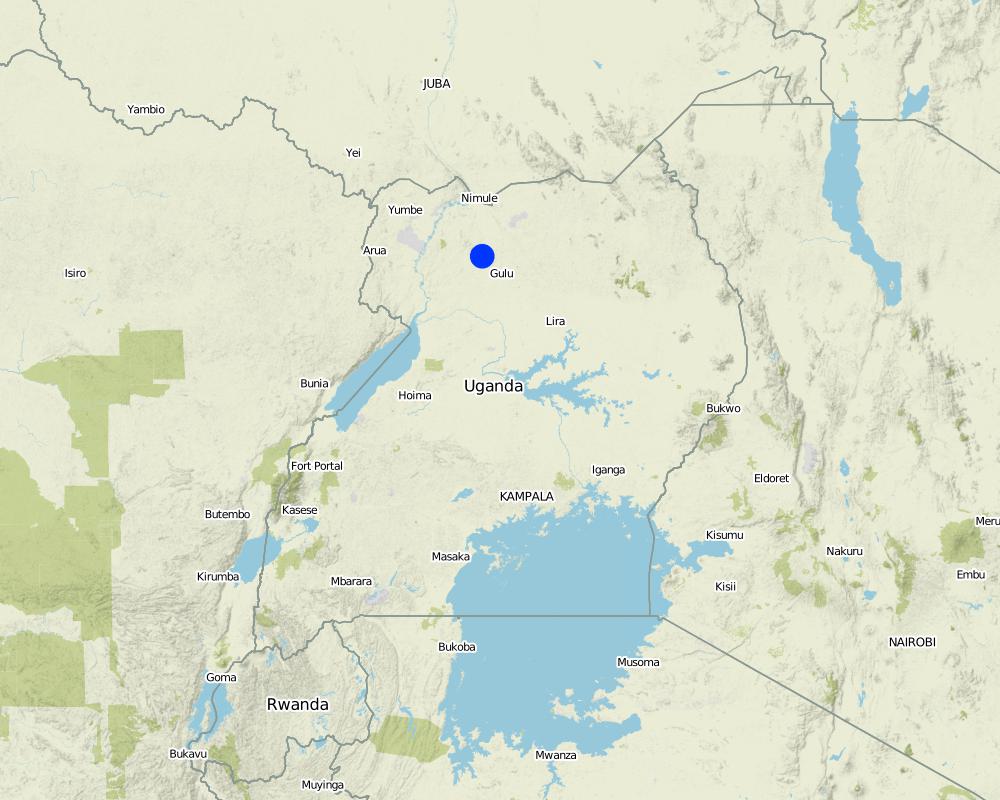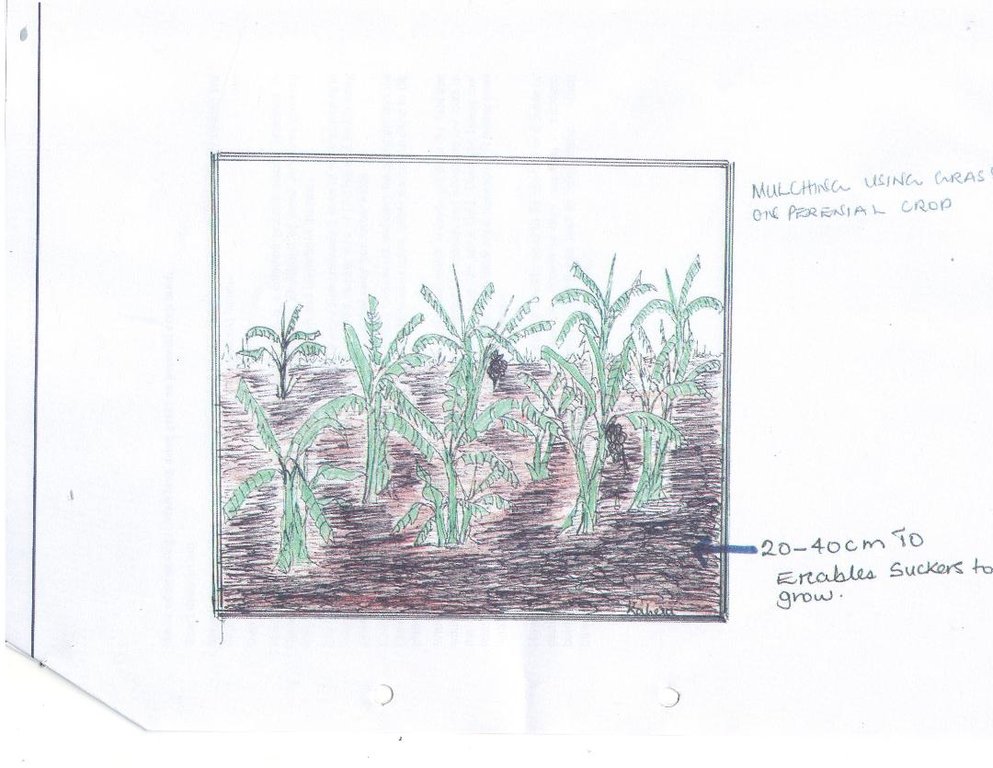Mulching using grass on perennial crop land. [乌干达]
- 创建:
- 更新:
- 编制者: Kamugisha Rick Nelson
- 编辑者: JOY TUKAHIRWA, Richard Otto Kawawa, Bernard Fungo
- 审查者: Donia Mühlematter, John Stephen Tenywa, Drake Mubiru, Nicole Harari, Renate Fleiner, Stephanie Jaquet, Alexandra Gavilano
Pot Labolo me umu poto
technologies_2818 - 乌干达
查看章节
全部展开 全部收起1. 一般信息
1.2 参与该技术评估和文件编制的资源人员和机构的联系方式
关键资源人
土地使用者:
Nyeko Richard
Gen Gari Farm
乌干达
有助于对技术进行记录/评估的项目名称(如相关)
Scaling-up SLM practices by smallholder farmers (IFAD)有助于对技术进行记录/评估的机构名称(如相关)
CDE Centre for Development and Environment (CDE Centre for Development and Environment) - 瑞士1.3 关于使用通过WOCAT记录的数据的条件
编制者和关键资源人员接受有关使用通过WOCAT记录数据的条件。:
是
1.4 所述技术的可持续性声明
这里所描述的技术在土地退化方面是否存在问题,导致无法被认为是一种可持续的土地管理技术?:
否
2. SLM技术的说明
2.1 技术简介
技术定义:
Laying grass (Poaceae) on perennial cropped land to reduce weeds, retain soil moisture and improve soil fertility.
2.2 技术的详细说明
说明:
Mulching using grass (Poaceae) on banana cropped land is a common practice usually promoted by farmers in Northern Uganda with the aim of increasing soil fertility, reducing the likelihood of weed problems growing around perennial plants, increase production and household income.
The farmer identifies a field planted with banana approximately 2 acres of land measuring at least 80 metres wide and 240 metres long located on a gentle sloping area of (3-5%), and mulch using grass which is grown in the planted banana garden. The mulch grass used comes from the same field carried away from other fields.
Using a panga the farmer uses 5 people paid on daily basis to cut and carry the grass and lay the grass at a distance of not more than 20- 40 cm to enable the suckers grow and to allow manure too close to the plant after grass decomposition and helps weeds control,
With this technology, the farmer uses locally obtained grass mulch which is easily comes from the banana field that would considered a waste. Secondly the associated costs are only related to transport and labour are low both in the short and long term since the mulch used is obtained from the same field. Costs for labour and transport are incurred only when the mulch material is carried from other areas. Some others costs are for weeding which would be borne by the farmer.
However, the farmer need to know that organic mulches usually need to be applied in a loose or partially-rotted state or the first stages of decomposition, otherwise they can lead to nitrogen being taken from the soil, or anaerobic decomposition which can lead to ‘sour mulch’ which turns acidic and damages the plants it is supposed to be protecting. This advice can best be extended to the farmer by extension workers and expert farmers who the farmer needs to be if close contact during implementation of this technology.
2.3 技术照片
2.4 技术视频
注释、简短说明:
Video showing Mulching using grass on perennial crop land under banana in Amuru District.
日期:
15/12/2017
位置:
Amuru District, Northern Uganda
摄影师的名字:
Issa Aiga
2.5 已应用该技术的、本评估所涵盖的国家/地区/地点
国家:
乌干达
区域/州/省:
Northern Region,Uganda
有关地点的进一步说明:
Amuru District, Northern Uganda
具体说明该技术的分布:
- 均匀地分布在一个区域
如果不知道精确的区域,请注明大致覆盖的区域:
- < 0.1 平方千米(10 公顷)
注释:
Map showing technology site in Northern Uganda.
Map
×2.6 实施日期
注明实施年份:
2010
如果不知道确切的年份,请说明大概的日期:
- 不到10年前(最近)
2.7 技术介绍
详细说明该技术是如何引入的:
- 通过土地使用者的创新
- 通过项目/外部干预
注释(项目类型等):
The farmer was supported with training by National Agricultural Advisory Services (NAADS).
3. SLM技术的分类
3.1 该技术的主要目的
- 改良生产
- 减少、预防、恢复土地退化
- 适应气候变化/极端天气及其影响
- 创造有益的经济影响
3.2 应用该技术的当前土地利用类型

农田
- 一年一作
- 多年一作(非木材)
多年生(非木质)作物 - 指定作物:
- 香蕉/芭蕉/蕉麻
每年的生长季节数:
- 2
具体说明:
Around June - August and February.
注释:
The farmer has a plantation of 0.5 acres planted next to the banana plantation.
3.4 供水
该技术所应用土地的供水:
- 雨养
注释:
integrated soil fertility management
water harvesting
3.5 该技术所属的SLM组
- 土壤肥力综合管理
- 集水
3.6 包含该技术的可持续土地管理措施

农艺措施
- A1:植被和土壤覆盖层
- A2:有机质/土壤肥力

植物措施
- V2:草和多年生草本植物
- V3:植被的清理

结构措施
- S7:集水/供水/灌溉设备

管理措施
- M3:根据自然和人文环境进行布局
- M5:物种组成的控制/变化
3.7 该技术强调的主要土地退化类型

土壤水蚀
- Wt:表土流失/地表侵蚀
- Wg:冲沟侵蚀/沟蚀

化学性土壤退化
- Cn:肥力下降和有机质含量下降(非侵蚀所致)

生物性退化
- Bc:植被覆盖的减少
- Bs:质量和物种组成/多样性的下降
- Bl:土壤寿命损失
3.8 防止、减少或恢复土地退化
具体数量名该技术与土地退化有关的目标:
- 防止土地退化
- 修复/恢复严重退化的土地
注释:
Due to the decomposition of the mulched grass material.
4. 技术规范、实施活动、投入和成本
4.1 该技术的技术图纸
4.2 有关投入和成本计算的一般信息
具体说明成本和投入是如何计算的:
- 每个技术区域
注明尺寸和面积单位:
2 acres
其它/国家货币(具体说明):
UGX
如相关,注明美元与当地货币的汇率(例如1美元=79.9巴西雷亚尔):1美元=:
3400.0
注明雇用劳工的每日平均工资成本:
5000
4.3 技术建立活动
| 活动 | 时间(季度) | |
|---|---|---|
| 1. | Select the site planted with banana | Before establishment |
| 2. | Look for pangas to cut the grass | Once before establishment |
| 3. | look for labour to cut and carry the grass | Before establishment |
| 4. | Cut and curry grass using labour | During establishment |
| 5. | Lay the grass in the soil | During establishment |
注释:
More workload for cutting, carrying and drying grass.
4.4 技术建立所需要的费用和投入
| 对投入进行具体说明 | 单位 | 数量 | 单位成本 | 每项投入的总成本 | 土地使用者承担的成本% | |
|---|---|---|---|---|---|---|
| 劳动力 | persons days for cutting, carrying and laying grass | persons | 5.0 | 150000.0 | 750000.0 | 100.0 |
| 设备 | Hoe | pieces | 5.0 | 10000.0 | 50000.0 | 100.0 |
| 设备 | Panga | Pieces | 5.0 | 7000.0 | 35000.0 | 100.0 |
| 植物材料 | Suckers in case the farmer want to add mulching | Suckers | 200.0 | 5000.0 | 1000000.0 | 100.0 |
| 其它 | Transport | Lorry | 1.0 | 100000.0 | 100000.0 | |
| 技术建立所需总成本 | 1935000.0 | |||||
| 技术建立总成本,美元 | 569.12 | |||||
注释:
Transport costs are incurred if the farmer obtains the grass from other area .
4.5 维护/经常性活动
| 活动 | 时间/频率 | |
|---|---|---|
| 1. | Add mulch to the banana field after decomposition | Twice a year |
注释:
The farmer may not need to incur additional costs if does not want to add mulch in the garden. This reduces labour costs.
4.6 维护/经常性活动所需要的费用和投入(每年)
| 对投入进行具体说明 | 单位 | 数量 | 单位成本 | 每项投入的总成本 | 土地使用者承担的成本% | |
|---|---|---|---|---|---|---|
| 劳动力 | Persons days for adding mulch | Persons | 3.0 | 150000.0 | 450000.0 | 100.0 |
| 技术维护所需总成本 | 450000.0 | |||||
| 技术维护总成本,美元 | 132.35 | |||||
4.7 影响成本的最重要因素
描述影响成本的最决定性因素:
Labour for cutting , carrying and laying grass and seedlings take the most costs. However this means that if the farmer does not need to add more suckers.
5. 自然和人文环境
5.1 气候
年降雨量
- < 250毫米
- 251-500毫米
- 501-750毫米
- 751-1,000毫米
- 1,001-1,500毫米
- 1,501-2,000毫米
- 2,001-3,000毫米
- 3,001-4,000毫米
- > 4,000毫米
指定年平均降雨量(若已知),单位为mm:
1400.00
有关降雨的规范/注释:
Two rainy season and two dry season.
Rainy season: March to May and September to November
Dry season: December to February and June - August
农业气候带
- 潮湿的
5.2 地形
平均坡度:
- 水平(0-2%)
- 缓降(3-5%)
- 平缓(6-10%)
- 滚坡(11-15%)
- 崎岖(16-30%)
- 陡峭(31-60%)
- 非常陡峭(>60%)
地形:
- 高原/平原
- 山脊
- 山坡
- 山地斜坡
- 麓坡
- 谷底
垂直分布带:
- 0-100 m a.s.l.
- 101-500 m a.s.l.
- 501-1,000 m a.s.l.
- 1,001-1,500 m a.s.l.
- 1,501-2,000 m a.s.l.
- 2,001-2,500 m a.s.l.
- 2,501-3,000 m a.s.l.
- 3,001-4,000 m a.s.l.
- > 4,000 m a.s.l.
说明该技术是否专门应用于:
- 凹陷情况
5.3 土壤
平均土层深度:
- 非常浅(0-20厘米)
- 浅(21-50厘米)
- 中等深度(51-80厘米)
- 深(81-120厘米)
- 非常深(> 120厘米)
土壤质地(表土):
- 中粒(壤土、粉土)
土壤质地(地表以下> 20厘米):
- 中粒(壤土、粉土)
表土有机质:
- 中(1-3%)
5.4 水资源可用性和质量
地下水位表:
< 5米
地表水的可用性:
中等
水质(未处理):
不良饮用水(需要处理)
水的盐度有问题吗?:
否
该区域正在发生洪水吗?:
否
5.5 生物多样性
物种多样性:
- 低
栖息地多样性:
- 低
5.6 应用该技术的土地使用者的特征
定栖或游牧:
- 定栖的
生产系统的市场定位:
- 生计(自给)
非农收入:
- 低于全部收入的10%
相对财富水平:
- 贫瘠
个人或集体:
- 个人/家庭
机械化水平:
- 手工作业
性别:
- 男人
土地使用者的年龄:
- 中年人
说明土地使用者的其他有关特征:
The farmer is a carpenter from which he derives his additional income.
5.7 应用该技术的土地使用者使用的平均土地面积
- < 0.5 公顷
- 0.5-1 公顷
- 1-2 公顷
- 2-5公顷
- 5-15公顷
- 15-50公顷
- 50-100公顷
- 100-500公顷
- 500-1,000公顷
- 1,000-10,000公顷
- > 10,000公顷
这被认为是小规模、中规模还是大规模的(参照当地实际情况)?:
- 小规模的
5.8 土地所有权、土地使用权和水使用权
土地所有权:
- 个人,未命名
土地使用权:
- 个人
用水权:
- 自由进入(无组织)
注释:
Presence of a community bore hole
5.9 进入服务和基础设施的通道
健康:
- 贫瘠
- 适度的
- 好
教育:
- 贫瘠
- 适度的
- 好
技术援助:
- 贫瘠
- 适度的
- 好
就业(例如非农):
- 贫瘠
- 适度的
- 好
市场:
- 贫瘠
- 适度的
- 好
能源:
- 贫瘠
- 适度的
- 好
道路和交通:
- 贫瘠
- 适度的
- 好
饮用水和卫生设施:
- 贫瘠
- 适度的
- 好
金融服务:
- 贫瘠
- 适度的
- 好
6. 影响和结论性说明
6.1 该技术的现场影响
社会经济效应
生产
作物生产
SLM之前的数量:
25 bunches per month.
SLM之后的数量:
35 bucnhes per month.
作物质量
注释/具体说明:
Water moisture retention, better growth.
土地管理
注释/具体说明:
Mulch grass locally available, less costs, use of local labour.
收入和成本
农业投入费用
注释/具体说明:
Purchase of hoes and pangas which don't take a lot of money.
农业收入
注释/具体说明:
From the sale of banana.
工作量
注释/具体说明:
Reduced work load in the long run.
社会文化影响
SLM/土地退化知识
注释/具体说明:
Knowledge on how to mulch and distance.
生态影响
水循环/径流
水量
注释/具体说明:
Retained by the mulched material.
水的回收/收集
注释/具体说明:
Due to use of mulch material.
地表径流
注释/具体说明:
Because of mulching.
土壤
土壤水分
注释/具体说明:
Kept within the mulch.
土壤覆盖层
注释/具体说明:
Mulch material.
土壤流失
注释/具体说明:
Reduced due to application of mulching
土壤有机物/地下C
注释/具体说明:
Due to decomposition of mulch grass.
6.2 该技术的场外影响已经显现
水资源可用性
注释/具体说明:
Kept within the mulch to be utilised by the banana during the dry season.
6.3 技术对渐变气候以及与气候相关的极端情况/灾害的暴露和敏感性(土地使用者认为的极端情况/灾害)
渐变气候
渐变气候
| 季节 | 增加或减少 | 该技术是如何应对的? | |
|---|---|---|---|
| 年温度 | 减少 | 非常好 | |
| 季节性温度 | 湿季/雨季 | 增加 | 好 |
| 年降雨量 | 减少 | 适度 |
气候有关的极端情况(灾害)
生物灾害
| 该技术是如何应对的? | |
|---|---|
| 昆虫/蠕虫侵扰 | 适度 |
6.4 成本效益分析
技术收益与技术建立成本相比如何(从土地使用者的角度看)?
短期回报:
积极
长期回报:
非常积极
技术收益与技术维护成本/经常性成本相比如何(从土地使用者的角度看)?
短期回报:
积极
长期回报:
积极
注释:
Mulching using grass reduced workload in the short run associated with less costs in the long run .The labour that would be used for weeding and its associated costs reduce since no weeding is required when the banana is mulched. Mulching reduces weeds and increases water moist which increases banana production due to decomposed mulched material (grass).
6.5 技术采用
- 1-10%
如若可行,进行量化(住户数量和/或覆盖面积):
5
在所有采用这项技术的人当中,有多少人是自发的,即未获得任何物质奖励/付款?:
- 0-10%
6.6 适应
最近是否对该技术进行了修改以适应不断变化的条件?:
是
若是,说明它适应了哪些变化的条件:
- 气候变化/极端气候
具体说明技术的适应性(设计、材料/品种等):
Planting fertilizer trees (Calliandra).
6.7 该技术的优点/长处/机会
| 土地使用者眼中的长处/优势/机会 |
|---|
| Control weeds and improve soil fertility after decomposition. |
| Uses local available grass materials within the banana (musa) garden for mulching which would be considered a waste. |
| Cost effective. Low labour and transport costs since the grass mulch is locally obtained within the same field. |
| 编制者或其他关键资源人员认为的长处/优势/机会 |
|---|
| Appropriate for farmers with low income. |
| Is scalable, requires low labour and input costs. |
6.8 技术的弱点/缺点/风险及其克服方法
| 土地使用者认为的弱点/缺点/风险 | 如何克服它们? |
|---|---|
| Harbours insects which attack young suckers. | Apply pesticides. |
| The technology is easily affected by roaming animals searching for pasture during the dry season when there is normally shortage of pasture. |
Put in place byelws on controlled grazing Integrate fertilizer trees (calliandra and Grivellea) in the practice as an alternative. |
| 编制者或其他关键资源人员认为的弱点/缺点/风险 | 如何克服它们? |
|---|---|
| Mulching can increase the risk of diseases especially if the grasses are obtained from outside the garden. | First use the grass in the same field. |
| Mulching alone may not be a solution to increase production. The farmer needs also to mange well the banana by cutting banana leaves which can also act as mulching material. | Knowledge and skills be provided by the extension agent. |
7. 参考和链接
7.1 信息的方法/来源
- 实地考察、实地调查
01
- 与土地使用者的访谈
01
(现场)数据是什么时候汇编的?:
25/05/2017
链接和模块
全部展开 全部收起链接
无链接
模块
无模块


